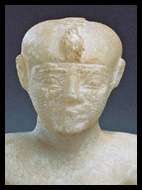Neferkare Phiops II
 (Son Of Re, Pepi,
Ka Of Re Is Beautiful)
(85) 2269-2184BC
(Son Of Re, Pepi,
Ka Of Re Is Beautiful)
(85) 2269-2184BC
|
|||||||||||||||||||||||||
|
Pepi II became pharaoh at the age of 6, and ushered in possibly the
longest reign by an Egyptian pharaoh -- possibly as long as 94
years. Pepi II is the last well-attested pharaoh of the Old Kingdom.
The First Intermediate Period that follows is a tumultuous time with
multiple royal families and regional kings. Of course, since he was
so young, early power in his reign lay with his mother,
Ankhnesmerire II and possibly her brother, Djau, who was vizier to
Pepi I and Merenre.
The gradual decline of the Sixth Dynasty -- indeed, of centralized Egyptian government at all -- continued with Pepi II's reign. The earlier policy of consolidating the power of the king had begun to fail. Near the end of his reign, the aging Pepi II was no longer able to rule explicitly himself and the power of the regional administrations would have grown, possibly leading to the breakup of the First Intermediate Period. At one point, power was so thinly spread that Pepi appointed a vizier for Upper Egypt and another for Lower Egypt in an attempt to consolidate his power, but this failed. Like his predecessors, Pepi II sent trading missions to Nubia and to Punt., and it was these expeditions and commercial trading efforts that drained the coffers of the central government. As Pepi continued to lose power, the central administration for taxation was virtually ignored by local and regional leaders. During this time, the commercial and diplomatic relationships with foreign countries also were severed (except the trade with Byblos). Near the end of his reign, the government simply collapsed. Like all the pharaohs of the Sixth Dynasty, he built his funerary complex in South Saqqara, very near the pyramid of Shepseskaf (Fourth Dynasty), and only a kilometer or so away from his father's and brother's pyramids. The name of his pyramid was "The Established and Living Pyramid". Three of his wives were buried in subsidiary pyramids near his own. The pyramid was investigated in the late 1830s by Perring, and a black granite sarcophagus was discovered with his name and titles on it. The mummy, however, was never found. Maspero was nearly buried alive in a cave-in while investigating the burial chambers, in 1881. Pepi's funerary monument is usually considered inferior work, poorly built and shabbily decorated. For some, this is evidence that there was a general decline in welfare during his reign, probably because of poor harvests. With less agricultural production, the egyptian economy suffered greatly. The entirety of his reign can be seen as a long, slow, unraveling into he upheaval of the Intermediate Period. Dating references to Neferkare -- the king's "throne name" --
must be done carefully, as the name is shared by many pharaohs of
different periods. Only when it can be corroborated can it be used.
Even with the higher standard, a reign of between 60 and 90 years
seems reasonable.
|
|||||||||||||||||||||||||
